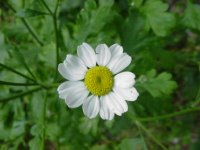
Chamomile
Prairial 22
...the chamomile, the more it is trodden on, the faster it grows...
Henry IV, Shakespeare
The flower of the day according to the French Republican Calendar is Camomile (Camomille in French). The easy way to get intimately acquainted with this plant is to make yourself a cup of Camomile tea, and if you don’t have any, head down to the nearest store to get some.
There are two kinds of Camomile: Roman (Chamaemelum nobile, formerly Anthemis nobilis) and German (Matricaria chamomilla). They are both members of the Compositae (the Daisy/Aster family). Roman chamomile grows close to the ground, forming a thick mat of green. Mary Preus recommends planting it between stepping stones. The English often used it for lawns. German chamomile is leggier. Preus says you can tell the difference between the two by slicing open the domed center of a flower. German chamomile has hollow receptacles while in Roman chamomile, the receptacles are solid. Both have feathery leaves, small daisy-like blossoms and a faint scent of apple (from whence they get their name: chamomile means “ground apple” in Greek and in Spain the herb is called manzanilla or little apple).
Chamomile has been known for centuries as a calming herb--Peter Rabbit has a cup after a hard day in the garden. According to Preus, both varieties have similar qualities but German chamomile is considered medically superior. It contains more chamazulene, a constituent that is a pain-killer, anti-inflammatory, antispasmodie and antiallergenic. This is the chamomile usually found in chamomile tea, which is often prescribed as a sleep aid or to soothe an upset stomach. Preus says that it is ready to pick when the centers turn from bright yellow to light brown. Pluck or snip the flowers off the stems and dry them on screens or newspapers at room temperature.
The Roman (or English) chamomile has the same qualities but to a lesser extent. It is primarily used externally in lotions, creams and ointments. To make an ointment of chamomile, Jeanne Rose recommends a process developed by the Egyptians of steeping the flowers in oil for 24 hours or more, t hen straining them out. Rub this ointment over the body of a person suffering from flu or rheumatism, put them in bed, wrap them warmly and let them sweat it out.
hen straining them out. Rub this ointment over the body of a person suffering from flu or rheumatism, put them in bed, wrap them warmly and let them sweat it out.
According to Mrs. M Grieve, chamomile was called “the plant’s physician” by ancient herbalists and if planted near ailing plants would help revive them. It was one of the nine sacred herbs of the Saxons (under the name maythen). In the language of flowers it represents: humility, calm and patience in adversity.
Warning: Some folks with allergies may be allergic to chamomile.
For much more about chamomile, I recommend my favorite herbal web site:
http://botanical.com/botanical/mgmh/c/chammo49.html
Preus, Mary , The Northwest Herb Lover’s Handbook, Sasquatch Press, 2000
Rodale’s Illustrated Encyclopedia of Herbs, edited by Claire Kowalchik and William H. Hylton, Rodale 1987
Rose, Jeanne, Herbs and Things, Grosset and Dunlap 1972
Simmons, Adelma Grenier, Country Wreaths from Caprilands, Rodale 1988
I found the picture at the top of German chamomile on an Italian website:
http://www.meditflora.com/flora/matricaria.htm
And the picture of a single blossom of the Roman chamomile on a French site:
http://environnement.ecoles.free.fr/pages%20images/nature-photos-images-chamaemelum%20nobile%20-%20camomille%20romaine-1_jpg.htm
1 comment:
Camomile, I adore it, and now a few minutes for bedtime, I am drinking a lovely large mug of camomile tea - thank you for all the lovely lore about this splendid garden creature.
Post a Comment